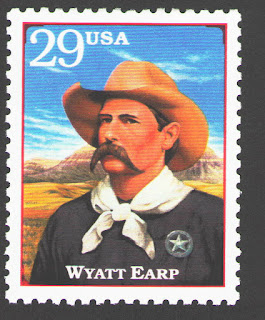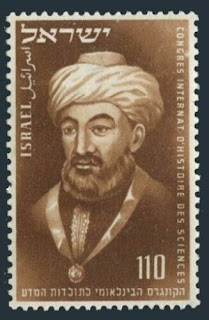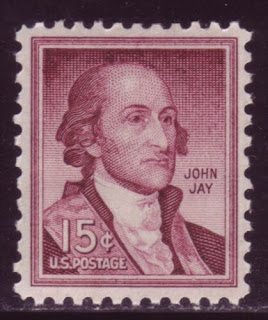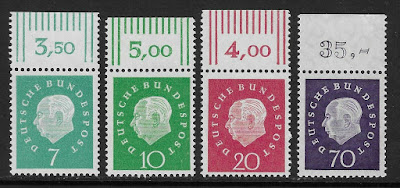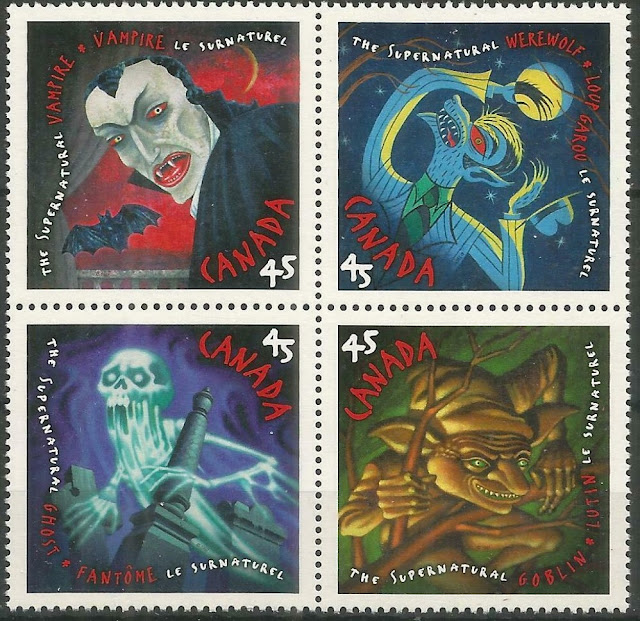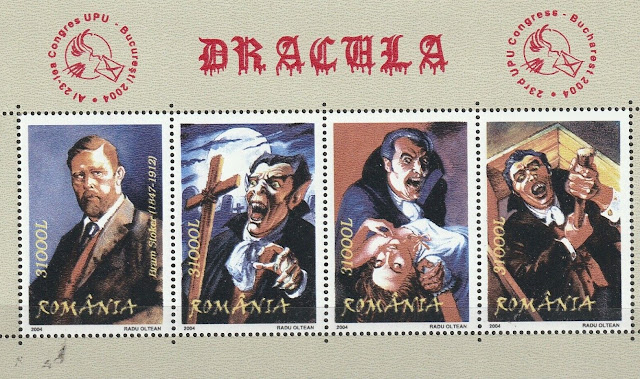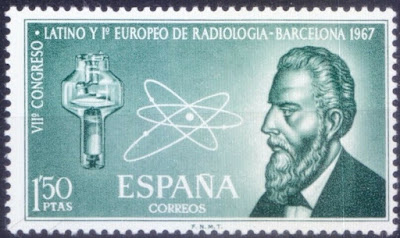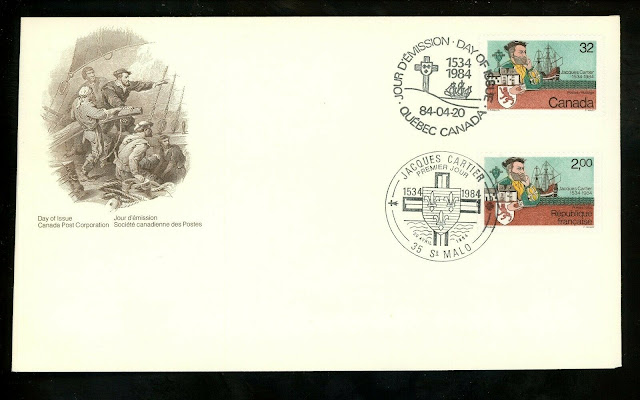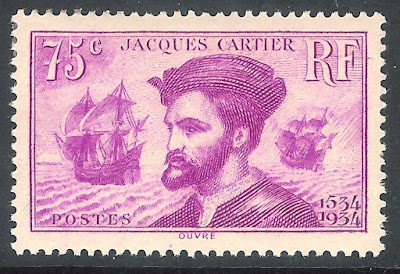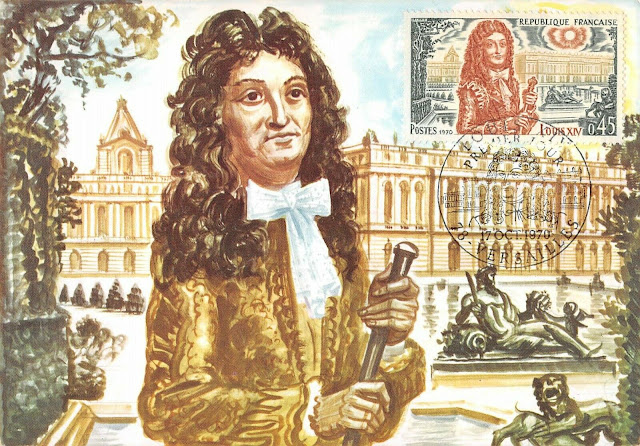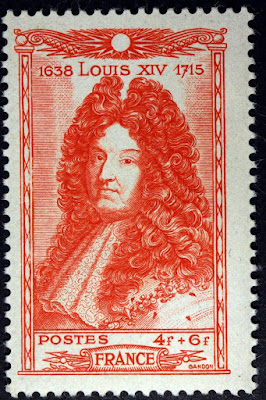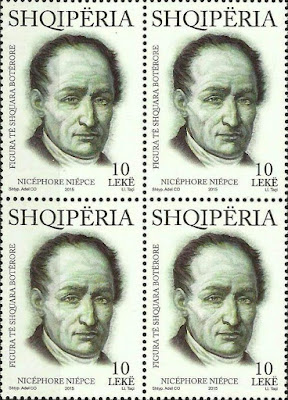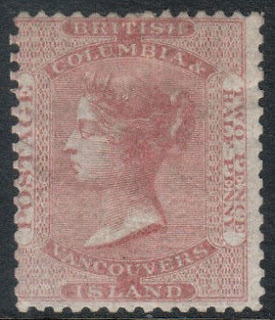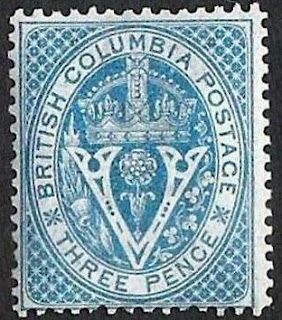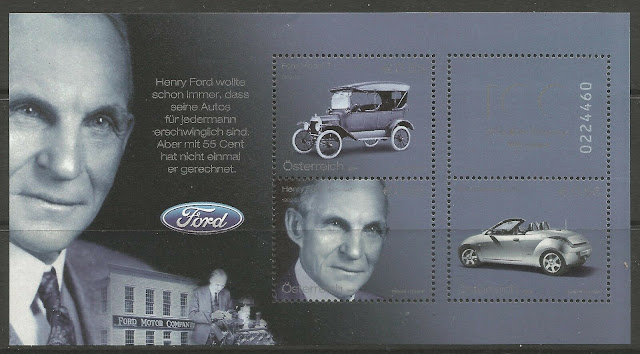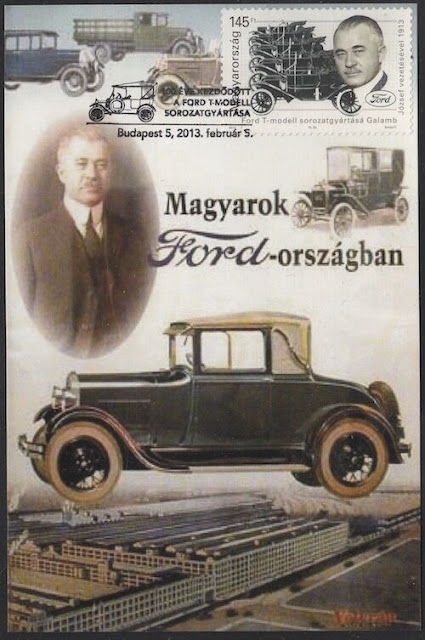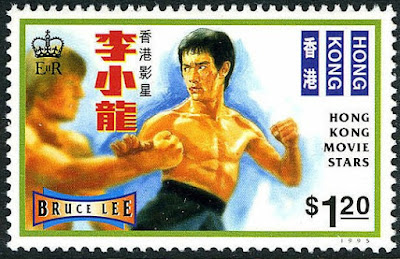Monday, January 13, 2020
January 13th in stamps Vancouver Island, Wyatt Earp, James Joyce
1849 – Establishment of the Colony of Vancouver Island.
The Colony of Vancouver Island, officially known as the Island of Vancouver and its Dependencies, was a Crown colony of British North America from 1849 to 1866, after which it was united with the mainland to form the Colony of British Columbia. The united colony joined Canadian Confederation, thus becoming part of Canada, in 1871. The colony comprised Vancouver Island and the Gulf Islands of the Strait of Georgia
Captain James Cook was the first European to set foot on the Island at Nootka Sound in 1778, claiming the territory for Great Britain. Fourteen years later, under the provisions of the Nootka Convention, Spain ceded its claims to Vancouver Island and the adjoining islands (including the Gulf Islands). It was not until 1843, however, that Britain – under the auspices of the Hudson's Bay Company (HBC) – established a settlement on Vancouver Island. The settlement was in the form of a fur trading post originally named Fort Albert (afterward Fort Victoria). The fort was located at the Songhees settlement of Camosack (Camosun), 200 meters northwest of the present-day Empress Hotel on Victoria's Inner Harbour.
With the signing of the Treaty of Washington in 1846, the mainland of Oregon Territory below the 49th parallel became American territory. Thus in 1849, HBC moved its western headquarters from Fort Vancouver on the Columbia River (present day Vancouver, Washington) to Fort Victoria. Chief Factor James Douglas, was relocated from Fort Vancouver to Fort Victoria to oversee the Company's operations west of the Rockies.
This development prompted the British colonial office to designate the territory a Crown colony on 13 January 1849. The colony was immediately leased to the HBC for a ten-year period, and Douglas was charged with encouraging British settlement. Richard Blanshard was named the colony's governor. Blanshard discovered that the hold of the HBC over the affairs of the new colony was all but absolute, and that it was Douglas who held all practical authority in the territory. There was no civil service, no police, no militia, and virtually every British colonist was an employee of the HBC. Frustrated, Blanshard abandoned his post a year later, returning to England. In 1851, his resignation was finalised, and the colonial office appointed Douglas as governor.
1929 Died: Wyatt Earp, American police officer (b. 1848)
Wyatt Berry Stapp Earp (March 19, 1848 – January 13, 1929) was an American Old West lawman and gambler in Cochise County, Arizona Territory, and a deputy marshal in Tombstone. He worked in a wide variety of trades throughout his life and took part in the famous gunfight at the O.K. Corral, during which lawmen killed three outlaw Cochise County Cowboys. He is often erroneously regarded as the central figure in the shootout, although his brother Virgil was Tombstone city marshal and deputy U.S. marshal that day and had far more experience as a sheriff, constable, marshal, and soldier in combat.
Earp was also a professional gambler, teamster, and buffalo hunter, and he owned several saloons, maintained a brothel, mined for silver and gold, and refereed boxing matches. He spent his early life in Pella, Iowa. In 1870, he married Urilla Sutherland who contracted typhoid fever and died shortly before their first child was to be born. During the next two years, Earp was arrested for stealing a horse, escaped from jail, and was sued twice. He was arrested and fined three times in 1872 for "keeping and being found in a house of ill-fame". His third arrest was described at length in the Daily Transcript, which referred to him as an "old offender" and nicknamed him the "Peoria Bummer", another name for loafer or vagrant.
By 1874, he arrived in the boomtown of Wichita, Kansas, where his reputed wife opened a brothel. On April 21, 1875, he was appointed to the Wichita police force and developed a solid reputation as a lawman, but he was fined and dismissed from the force after getting into a fistfight with a political opponent of his boss. Earp immediately left Wichita, following his brother James to Dodge City, Kansas, where he became an assistant city marshal. In the winter of 1878, he went to Texas to track down an outlaw, and he met John "Doc" Holliday whom Earp credited with saving his life.
Earp moved constantly throughout his life from one boomtown to another. He left Dodge City in 1879 and moved with brothers James and Virgil to Tombstone, where a silver boom was underway. The Earps clashed with an informal group of outlaws known as the "Cowboys". Wyatt, Virgil, and their younger brother Morgan held various law-enforcement positions which put them in conflict with Tom McLaury, Frank McLaury, Ike Clanton, and Billy Clanton who threatened to kill the Earps on several occasions. The conflict escalated over the next year, culminating in the shoot out at the O.K. Corral on October 26, 1881, in which the Earps and Doc Holliday killed three of the Cowboys. In the next five months, Virgil was ambushed and maimed, and Morgan was assassinated. Wyatt, Warren Earp, Doc Holliday, and others formed a federal posse which killed three of the Cowboys whom they thought responsible. Wyatt was never wounded in any of the gunfights, unlike his brothers Virgil and Morgan or his friend Doc Holliday, which only added to his mystique after his death.
Earp was a lifelong gambler and was always looking for a quick way to make money. After leaving Tombstone, he went to San Francisco where he reunited with Josephine Marcus, and she became his common-law wife. They joined a gold rush to Eagle City, Idaho, where they owned mining interests and a saloon. They left there to race horses and open a saloon during a real estate boom in San Diego, California. Back in San Francisco, Wyatt raced horses again, but his reputation suffered irreparably when he refereed the Fitzsimmons vs. Sharkey boxing match and called a foul which led many to believe that he fixed the fight. They moved briefly to Yuma, Arizona, before joining the Nome Gold Rush in 1899. He and Charlie Hoxie paid $1,500 (about $51,000 in 2018) for a liquor license to open a two-story saloon called the Dexter and made an estimated $80,000 (about $2 million in 2017 dollars). The couple then left Alaska and opened another saloon in Tonopah, Nevada, the site of a new gold find. Around 1911, Earp began working several mining claims in Vidal, California, retiring in the hot summers with Josephine to Los Angeles. He made friends among early Western actors in Hollywood and tried to get his story told, but he was portrayed only very briefly in one film produced during his lifetime: Wild Bill Hickok (1923).
Earp died on January 13, 1929. He was known as a Western lawman, gunfighter, and boxing referee. He had a notorious reputation for both his handling of the Fitzsimmons–Sharkey fight and his role in the O.K. Corral gunfight. This only began to change after his death when the extremely flattering biography Wyatt Earp: Frontier Marshal was published in 1931. It became a bestseller and created his reputation as a fearless lawman. Since then, Earp has been the subject of numerous films, television shows, biographies, and works of fiction which have increased both his fame and his notoriety. Long after his death, he has many devoted detractors and admirers. His modern-day reputation is that of the Old West's toughest and deadliest gunman.
US stamp and First Day Cover depicting Wyatt Earp
1941 Died: James Joyce, Irish novelist, short story writer, and poet (b. 1882)
James Augustine Aloysius Joyce (2 February 1882 – 13 January 1941) was an Irish novelist, short story writer, poet, teacher, and literary critic. He contributed to the modernist avant-garde and is regarded as one of the most influential and important authors of the 20th century. Joyce is best known for Ulysses (1922), a landmark work in which the episodes of Homer's Odyssey are paralleled in a variety of literary styles, most famously stream of consciousness. Other well-known works are the short-story collection Dubliners (1914), and the novels A Portrait of the Artist as a Young Man (1916) and Finnegans Wake (1939). His other writings include three books of poetry, a play, his published letters and occasional journalism.
Joyce was born in Dublin into a middle-class family. A brilliant student, he briefly attended the Christian Brothers-run O'Connell School before excelling at the Jesuit schools Clongowes and Belvedere, despite the chaotic family life imposed by his father's unpredictable finances. He went on to attend University College Dublin.
In 1904, in his early twenties, Joyce emigrated to continental Europe with his partner (and later wife) Nora Barnacle. They lived in Trieste, Paris, and Zürich. Although most of his adult life was spent abroad, Joyce's fictional universe centres on Dublin and is populated largely by characters who closely resemble family members, enemies and friends from his time there. Ulysses in particular is set with precision in the streets and alleyways of the city. Shortly after the publication of Ulysses, he elucidated this preoccupation somewhat, saying, "For myself, I always write about Dublin, because if I can get to the heart of Dublin I can get to the heart of all the cities of the world. In the particular is contained the universal."
Irish stamps commemorating James Joyce
Thursday, December 12, 2019
December 12th in stamps Maimonides, Marconi, Willem I, Edvard Munch, Theodor Heus, John Jay
1204 Died Maimonides, Egyptian religious scholar, philosopher and physician (b. 1135)
Moses ben Maimon, commonly known as Maimonides and also referred to by the acronym Rambam, was a medieval Sephardic Jewish philosopher who became one of the most prolific and influential Torah scholars of the Middle Ages. In his time, he was also a preeminent astronomer and physician. Born in Córdoba, Almoravid empire (present-day Spain) on Passover Eve, 1135 or 1138, he worked as a rabbi, physician, and philosopher in Morocco and Egypt. He died in Egypt on December 12, 1204, whence his body was taken to the lower Galilee and buried in Tiberias.
During his lifetime, most Jews greeted Maimonides' writings on Jewish law and ethics with acclaim and gratitude, even as far away as Iraq and Yemen. Yet, while Maimonides rose to become the revered head of the Jewish community in Egypt, his writings also had vociferous critics, particularly in Spain. Nonetheless, he was posthumously acknowledged as among the foremost rabbinical decisors and philosophers in Jewish history, and his copious work comprises a cornerstone of Jewish scholarship. His fourteen-volume Mishneh Torah still carries significant canonical authority as a codification of Talmudic law. He is sometimes known as "ha Nesher ha Gadol" (the great eagle) in recognition of his outstanding status as a bona fide exponent of the Oral Torah.
Aside from being revered by Jewish historians, Maimonides also figures very prominently in the history of Islamic and Arab sciences and is mentioned extensively in studies. Influenced by Al-Farabi, Avicenna, and his contemporary Averroes, he in his turn influenced other prominent Arab and Muslim philosophers and scientists. He became a prominent philosopher and polymath in both the Jewish and Islamic worlds.
Stamps from Israel and Uruguay depicting Maimonides
1745 Born: John Jay, American politician and diplomat, 1st Chief Justice of the United States (d. 1829)
John Jay (December 12, 1745 – May 17, 1829) was an American statesman, patriot, diplomat, Founding Father, abolitionist, negotiator, and signatory of the Treaty of Paris of 1783. He served as the second Governor of New York and the first Chief Justice of the United States (1789–1795). He directed U.S. foreign policy for much of the 1780s and was an important leader of the Federalist Party after the ratification of the United States Constitution in 1788.
Jay was born into a wealthy family of merchants and New York City government officials of French Huguenot and Dutch descent. He became a lawyer and joined the New York Committee of Correspondence, organizing American opposition to British policies such as the Intolerable Acts in the leadup to the American Revolution. Jay was elected to the Second Continental Congress, and served as President of the Congress. From 1779 to 1782, Jay served as the ambassador to Spain; he persuaded Spain to provide financial aid to the fledgling United States. He also served as a negotiator of the Treaty of Paris, in which Britain recognized American independence. Following the end of the war, Jay served as Secretary of Foreign Affairs, directing United States foreign policy under the Articles of Confederation government. He also served as the first Secretary of State on an interim basis.
A proponent of strong, centralized government, Jay worked to ratify the United States Constitution in New York in 1788. He was a co-author of The Federalist Papers along with Alexander Hamilton and James Madison, and wrote five of the eighty-five essays. After the establishment of the new federal government, Jay was appointed by President George Washington the first Chief Justice of the United States, serving from 1789 to 1795. The Jay Court experienced a light workload, deciding just four cases over six years. In 1794, while serving as Chief Justice, Jay negotiated the highly controversial Jay Treaty with Britain. Jay received a handful of electoral votes in three of the first four presidential elections, but never undertook a serious bid for the presidency.
Jay served as the Governor of New York from 1795 to 1801. Although he successfully passed gradual emancipation legislation as governor of the state, he himself owned five enslaved people as late as 1800. In the waning days of President John Adams's administration, Jay was confirmed by the Senate for another term as Chief Justice, but he declined the position and retired to his farm in Westchester County, New York.
US stamp depicting John Jay
William I (Willem Frederik, Prince of Orange-Nassau; 24 August 1772 – 12 December 1843) was a Prince of Orange and the first King of the Netherlands and Grand Duke of Luxembourg.
He was the ruler of the Principality of Nassau-Orange-Fulda from 1803 until 1806 and of the Principality of Orange-Nassau in the year 1806 and from 1813 until 1815. In 1813 he proclaimed himself Sovereign Prince of the United Netherlands. He proclaimed himself King of the Netherlands and Duke of Luxembourg on 16 March 1815. In the same year on 9 June William I became also the Grand Duke of Luxembourg and after 1839 he was furthermore the Duke of Limburg. After his abdication in 1840 he styled himself King William Frederick, Count of Nassau.
Dutch stamps issued in 1913 depicting King William I
1963 Born: Edvard Munch, Norwegian painter and illustrator (d. 1944)
Edvard Munch (12 December 1863 – 23 January 1944) was a Norwegian painter. His best known work, The Scream, has become one of the most iconic images of world art.
His childhood was overshadowed by illness, bereavement and the dread of inheriting a mental condition that ran in the family. Studying at the Royal School of Art and Design in Kristiania (today's Oslo), Munch began to live a bohemian life under the influence of nihilist Hans Jæger, who urged him to paint his own emotional and psychological state ('soul painting'). From this emerged his distinctive style.
Travel brought new influences and outlets. In Paris, he learned much from Paul Gauguin, Vincent van Gogh and Henri de Toulouse-Lautrec, especially their use of colour. In Berlin, he met Swedish dramatist August Strindberg, whom he painted, as he embarked on his major canon The Frieze of Life, depicting a series of deeply-felt themes such as love, anxiety, jealousy and betrayal, steeped in atmosphere.
The Scream was conceived in Kristiania. According to Munch, he was out walking at sunset, when he 'heard the enormous, infinite scream of nature'. The painting's agonised face is widely identified with the angst of the modern person. Between 1893 and 1910, he made two painted versions and two in pastels, as well as a number of prints. One of the pastels would eventually command the fourth highest nominal price paid for a painting at auction.
As his fame and wealth grew, his emotional state remained insecure. He briefly considered marriage, but could not commit himself. A breakdown in 1908 forced him to give up heavy drinking, and he was cheered by his increasing acceptance by the people of Kristiania and exposure in the city's museums. His later years were spent working in peace and privacy. Although his works were banned in Nazi Germany, most of them survived World War II, securing him a legacy.
Norwegian stamps depicting Edvard Munch's workd
1901 – Guglielmo Marconi receives the first transatlantic radio signal (the letter "S" [***] in Morse Code), at Signal Hill in St John's, Newfoundland.
Guglielmo Marconi, 1st Marquis of Marconi (25 April 1874 – 20 July 1937) was an Italian inventor and electrical engineer, known for his pioneering work on long-distance radio transmission,[5] development of Marconi's law, and a radio telegraph system. He is credited as the inventor of radio, and he shared the 1909 Nobel Prize in Physics with Karl Ferdinand Braun "in recognition of their contributions to the development of wireless telegraphy".
Marconi was also an entrepreneur, businessman, and founder of The Wireless Telegraph & Signal Company in the United Kingdom in 1897 (which became the Marconi Company). He succeeded in making an engineering and commercial success of radio by innovating and building on the work of previous experimenters and physicists. In 1929, Marconi was ennobled as a Marchese (marquis) by King Victor Emmanuel III of Italy, and, in 1931, he set up the Vatican Radio for Pope Pius XI.
Some stamps from the US, Italy, Bahamas, Canada and Niger depicting Marconi
1963 Died: Theodor Heuss, German journalist and politician, 1st President of the Federal Republic of Germany (b. 1884 )
Theodor Heuss (German: 31 January 1884 – 12 December 1963) was a German liberal politician who served as the first President of the Federal Republic of Germany from 1949 to 1959. His cordial nature – something of a contrast to the stern character of chancellor Konrad Adenauer – largely contributed to the stabilization of democracy in West Germany during the Wirtschaftswunder years. Before beginning his career as a politician, Heuss had been a political journalist.
After World War II the US Office of Military Government on 24 September 1945 appointed Heuss the first Minister of Education and Cultural Affairs in the German state of Württemberg-Baden under his fellow party member Minister-president Reinhold Maier, in favour of whom he resigned in 1946. As a co-founder of the Democratic People's Party (Demokratische Volkspartei, DVP), the predecessor of the German Free Democratic Party (Freie Demokratische Partei, FDP) in the southwestern German states, he was a member of the Württemberg-Baden state parliament (Landtag) from 1946 to 1949. Heuss also taught history at the Stuttgart Institute of Technology in 1946 and 1947, receiving the title of an honorary professor in 1948.
After plans elaborated with Wilhelm Külz to build up an all-German liberal party had failed, Heuss in December 1948 was elected head of West German and Berlin sections of the newly founded Free Democratic Party. He advocated uniting all liberal parties in the Western occupation zones, overcoming the split between right liberals and left liberals that had existed in the Weimar Republic. In 1948, he was a member of the Parlamentarischer Rat (Parliamentary Council) at Bonn with considerable influence in the drafting of West Germany's constitution, the Basic Law for the Federal Republic of Germany.
After being elected to the first German Bundestag, he relinquished his parliamentary mandate on 12 September 1949, when he was elected President by the Federal Convention (Bundesversammlung) defeating the Social Democrat leader Kurt Schumacher in the second ballot. He took the oath required by article 56 of the Basic Law before a joint session of the Bundestag and the Bundesrat on the same date. By the time he was confirmed as the first democratic German president since Paul von Hindenburg, he refused to be called “Excellency”, preferring instead to be called simply “Herr Heuss”, Herr Bundespräsident is the German term of address up to today. Heuss's plans for a new national anthem were aborted by Adenauer, who – in rare accordance with Kurt Schumacher – had the third stanza of the old Deutschlandlied established in 1952.
A widower since 1952, Heuss was re-elected in 1954 with practically no opposition, after the Social Democrats had renounced the nomination of a rival candidate. Not until May 1956, could he make his first state visit, invited by King Paul of Greece. The president, accompanied by Foreign Minister Heinrich von Brentano, was overwhelmed by the warm reception in Athens, considering that the country had heavily suffered under German occupation in World War II. He held office until the end of his term on 12 September 1959, succeeded by Heinrich Lübke. He had declined a third term in office, as this would have necessitated changing the constitution.
Heuss shaped the office of president by his non-partisan governing. As a representative of the democratic-liberal and cultural traditions of Germany, he was a symbol of confidence in the German post-war republic in the international community. His further state visits to Turkey, Italy, Canada, the United States, and the United Kingdom contributed greatly to the increase of appreciation toward the still young Federal Republic of Germany. He was opposed to re-armament and the founding of the new West German Army in 1955, but had no power to stop it. His ironic speech at the swearing in of the first new soldiers, "Nun siegt mal schön!" ("Happy war-winning!"), is well remembered. In 1959, Heuss was awarded the prestigious Friedenspreis des Deutschen Buchhandels. In addressing the memory of Nazism and the Third Reich, Heuss introduced the concept of collective shame as opposed to collective guilt. His rhetoric encouraged the Germans to never forget the Holocaust and precisely described the crimes against the Jews but he refrained from citing those who were responsible for their suffering.
On 12 December 1963 Heuss died in Stuttgart, aged 79.
German stamps depicting Theodor Heuss
Friday, November 08, 2019
November 8th in stamps Wilhelm Röntgen, Bram Stoker, Witte de With
1658 Died: Witte de With, Dutch admiral (b. 1599)
Witte Corneliszoon de With (28 March 1599 – 8 November 1658) was a Dutch naval officer. He is noted for planning and participating in a number of naval battles during the Eighty Years War and the First Anglo-Dutch war.
In the Eighty Years' War against the Spanish, De With fought at the Battle of the Downs (1639). De With became very jealous of Tromp's popularity after his destruction of the Spanish fleet in The Downs. In the same battle, he made an enemy of Zealandic Vice-Admiral Johan Evertsen and accused him of cowardice and avarice.
Witte de With on stamps issued by the Netherlands and Sint Maarten
Abraham "Bram" Stoker (8 November 1847 – 20 April 1912) was an Irish author, best known today for his 1897 Gothic novel Dracula. During his lifetime, he was better known as the personal assistant of actor Sir Henry Irving, and business manager of the Lyceum Theatre in London, which Irving owned.
Stoker visited the English coastal town of Whitby in 1890, and that visit was said to be part of the inspiration for Dracula. He began writing novels while working as manager for Henry Irving and secretary and director of London's Lyceum Theatre, beginning with The Snake's Pass in 1890 and Dracula in 1897. During this period, Stoker was part of the literary staff of The Daily Telegraph in London, and he wrote other fiction, including the horror novels The Lady of the Shroud (1909) and The Lair of the White Worm (1911). He published his Personal Reminiscences of Henry Irving in 1906, after Irving's death, which proved successful, and managed productions at the Prince of Wales Theatre.
Before writing Dracula, Stoker met Ármin Vámbéry, a Slovak-Jewish writer and traveler (born in Szent-György, Kingdom of Hungary now Svätý Jur, Slovakia),. Dracula likely emerged from Vámbéry's dark stories of the Carpathian mountains. Stoker then spent several years researching Central and East European folklore and mythological stories of vampires.
The 1972 book In Search of Dracula by Radu Florescu and Raymond McNally claimed that the Count in Stoker's novel was based on Vlad III Dracula. At most however, Stoker borrowed only the name and "scraps of miscellaneous information" about Romanian history, according to one expert, Elizabeth Miller; further, there are no comments about Vlad III in the author's working notes.
Dracula is an epistolary novel, written as a collection of realistic but completely fictional diary entries, telegrams, letters, ship's logs, and newspaper clippings, all of which added a level of detailed realism to the story, a skill which Stoker had developed as a newspaper writer. At the time of its publication, Dracula was considered a "straightforward horror novel" based on imaginary creations of supernatural life. "It gave form to a universal fantasy ... and became a part of popular culture."
Stamps from Canada, Ireland and Romania depicting Bram Stoker's Dracula
1895 – While experimenting with electricity, Wilhelm Röntgen discovers the X-ray.
Wilhelm Conrad Röntgen (27 March 1845 – 10 February 1923) was a German mechanical engineer and physicist, who, on 8 November 1895, produced and detected electromagnetic radiation in a wavelength range known as X-rays or Röntgen rays, an achievement that earned him the first Nobel Prize in Physics in 1901. In honour of his accomplishments, in 2004 the International Union of Pure and Applied Chemistry (IUPAC) named element 111, roentgenium, a radioactive element with multiple unstable isotopes, after him.
Today, in Remscheid-Lennep, 40 kilometers east of Düsseldorf, the town in which Röntgen was born in 1845 is the Deutsches Röntgen-Museum.
In Würzburg, where he discovered the X-rays, a non-profit organization maintains his laboratory and provides guided tours to the Röntgen Memorial Site.
World Radiology Day: The International Day of Radiology is an annual event promoting the role of medical imaging in modern healthcare. It is celebrated on 8 November each year, coincides with the anniversary of the discovery of X-rays by Wilhelm Roentgen in 1895. It was first introduced in 2012, as a joint initiative, by the European Society of Radiology (ESR), the Radiological Society of North America (RSNA), and the American College of Radiology (ACR).
Röntgen Peak in Antarctica is named after Wilhelm Röntgen
Stamps from India, Germany and Spain depicting Wilhelm Röntgen
Sunday, September 01, 2019
September 1st in stamps Jacques Cartier, Engelbert Humperdinck, Louis XIV
1557 Died: Jacques Cartier, French navigator and explorer (b. 1491)
Jacques Cartier (December 31, 1491 – September 1, 1557) was a Breton explorer who claimed what is now Canada for France. Jacques Cartier was the first European to describe and map the Gulf of Saint Lawrence and the shores of the Saint Lawrence River, which he named "The Country of Canadas", after the Iroquois names for the two big settlements he saw at Stadacona (Quebec City) and at Hochelaga (Montreal Island).
Some stamps and a First Day Cover from France and Canada depicting Jacques Cartier
1715 Died: Louis XIV of France (b. 1638)
Louis XIV (Louis Dieudonné; 5 September 1638 – 1 September 1715), known as Louis the Great (Louis le Grand) or the Sun King (le Roi Soleil), was King of France from 14 May 1643 until his death in 1715. His reign of 72 years and 110 days is the longest recorded of any monarch of a sovereign country in European history. In the age of absolutism in Europe, Louis XIV's France was a leader in the growing centralization of power.
Louis began his personal rule of France in 1661, after the death of his chief minister, the Italian Cardinal Mazarin. An adherent of the concept of the divine right of kings, Louis continued his predecessors' work of creating a centralized state governed from the capital. He sought to eliminate the remnants of feudalism persisting in parts of France and, by compelling many members of the nobility to inhabit his lavish Palace of Versailles, succeeded in pacifying the aristocracy, many members of which had participated in the Fronde rebellion during Louis' minority. By these means he became one of the most powerful French monarchs and consolidated a system of absolute monarchical rule in France that endured until the French Revolution.
Some France stamps and a maximum card depicting Louis XIV
1854 Born: Engelbert Humperdinck, German playwright and composer (d. 1921)
Engelbert Humperdinck (1 September 1854 – 27 September 1921) was a German composer, best known for his opera Hansel and Gretel.
Humperdinck's reputation rests chiefly on his opera Hänsel und Gretel, which he began work on in Frankfurt in 1890. He first composed four songs to accompany a puppet show his nieces were giving at home. Then, using a libretto by his sister Adelheid Wette rather loosely based on the version of the fairy tale by the Brothers Grimm, he composed a singspiel of 16 songs with piano accompaniment and connecting dialogue. By January 1891 he had begun working on a complete orchestration.
The opera premiered in Weimar on 23 December 1893, under the baton of Richard Strauss. With its highly original synthesis of Wagnerian techniques and traditional German folk songs, Hansel and Gretel was an instant and overwhelming success.
Hansel and Gretel has always been Humperdinck's most popular work. In 1923 the Royal Opera House (London) chose it for their first complete radio opera broadcast. Eight years later, it was the first opera transmitted live from the Metropolitan Opera (New York).
Below is a German First Day Cover issued for the 150th birthday anniversary of Engelbert Humperdinck
Monday, July 22, 2019
July 22nd in stamps Alexander Mackenzie, Wiley Post, Randal Cremer
1793 – Alexander Mackenzie reaches the Pacific Ocean becoming the first recorded human to complete a transcontinental crossing of North America.
Sir Alexander Mackenzie (or MacKenzie, Scottish Gaelic: Alasdair MacCoinnich; 1764 – 12 March 1820) was a Scottish explorer known for accomplishing the first east to west crossing of North America north of Mexico, which preceded the more famous Lewis and Clark Expedition by 12 years. His overland crossing of what is now Canada reached the Pacific Ocean in 1793. The Mackenzie River, the longest river system in Canada and the second longest in North America, is named after him.
Canadian stamps issued to commemorate Alexander Mackenzie
1908 Died: Randal Cremer, English activist and politician, Nobel Prize laureate (b. 1828)
Stamp issued by Guinea Bissau depicting Randal Cremer
1933 – Aviator Wiley Post returns to Floyd Bennett Field in New York City, completing the first solo flight around the world in seven days, 18 hours and 49 minutes.
Wiley Hardeman Post (November 22, 1898 – August 15, 1935) was a famed American aviator during the interwar period, the first pilot to fly solo around the world. Also known for his work in high-altitude flying, Post helped develop one of the first pressure suits and discovered the jet stream. On August 15, 1935, Post and American humorist Will Rogers were killed when Post's aircraft crashed on takeoff from a lagoon near Point Barrow in the Territory of Alaska.
Post's Lockheed Vega aircraft, the Winnie Mae, was on display at the National Air and Space Museum's Steven F. Udvar-Hazy Center from 2003 to 2011. It is now featured in the "Time and Navigation" gallery on the second floor of the National Air and Space Museum in Washington, D.C.
Stamps issued to commemorate Wiley Post
Saturday, July 20, 2019
July 20th in Stamps Niépce British Columbia joins Canada, Moon landing, Ford ships 1st car, Bruce Lee died
1656 Born: Johann Bernhard Fischer von Erlach, Austrian architect, sculptor and historian (d. 1723)
Johann Bernhard Fischer von Erlach (20 July 1656 – 5 April 1723) was an Austrian architect, sculptor, and architectural historian whose Baroque architecture profoundly influenced and shaped the tastes of the Habsburg Empire. His influential book A Plan of Civil and Historical Architecture (1721) was one of the first and most popular comparative studies of world architecture. His major works include Schönbrunn Palace, Karlskirche, and the Austrian National Library in Vienna, and Schloss Klessheim, Holy Trinity Church, and the Kollegienkirche in Salzburg.
Austrian stamp depicting Johann Bernhard Fischer von Erlach
1807 – Nicéphore Niépce is awarded a patent by Napoleon for the Pyréolophore, the world's first internal combustion
Joseph Nicéphore Niépce (7 March 1765 – 5 July 1833), commonly known or referred to simply as Nicéphore Niépce, was a French inventor, usually credited as the inventor of photography and a pioneer in that field. Niépce developed heliography, a technique he used to create the world's oldest surviving product of a photographic process: a print made from a photoengraved printing plate in 1825. In 1826 or 1827, he used a primitive camera to produce the oldest surviving photograph of a real-world scene. Among Niépce's other inventions was the Pyréolophore, the world's first internal combustion engine, which he conceived, created, and developed with his older brother Claude.
Here are some stamps from Albania and France depicting Nicéphore Niépce
1871 – British Columbia joins the confederation of Canada.
British Columbia (BC; French: Colombie-Britannique) is the westernmost province of Canada, located between the Pacific Ocean and the Rocky Mountains. With an estimated population of 5.034 million as of 2019, it is Canada's third-most populous province.
With the agreement by the Canadian government to extend the Canadian Pacific Railway to British Columbia and to assume the colony's debt, British Columbia became the sixth province to join Confederation on July 20, 1871
Some early British Columbia stamps
1973 Died: Bruce Lee, American-Chinese actor, martial artist, and screenwriter (b. 1940)
Lee Jun-fan (Chinese: 李振藩; November 27, 1940 – July 20, 1973), commonly known as Bruce Lee (Chinese: 李小龍), was a Chinese, Hong Kong American actor, director, martial artist, martial arts instructor and philosopher. He was the founder of Jeet Kune Do, a hybrid martial arts philosophy drawing from different combat disciplines that is often credited with paving the way for modern mixed martial arts (MMA). Lee is considered by commentators, critics, media, and other martial artists to be the most influential martial artist of all time and a pop culture icon of the 20th century, who bridged the gap between East and West. He is credited with helping to change the way Asians were presented in American films.
The son of Cantonese opera star Lee Hoi-chuen, Lee was born in the Chinatown area of San Francisco, California, on November 27, 1940, to parents from Hong Kong, and was raised with his family in Kowloon, Hong Kong. He was introduced to the film industry by his father and appeared in several films as a child actor. Lee moved to the United States at the age of 18 to receive his higher education at the University of Washington in Seattle, and it was during this time that he began teaching martial arts. His Hong Kong and Hollywood-produced films elevated the traditional martial arts film to a new level of popularity and acclaim, sparking a surge of interest in the Chinese nation and Chinese martial arts in the West in the 1970s. The direction and tone of his films dramatically changed and influenced martial arts and martial arts films in the world.
He is noted for his roles in five feature-length martial arts films in the early 1970s: Lo Wei's The Big Boss (1971) and Fist of Fury (1972); Golden Harvest's Way of the Dragon (1972), directed and written by Lee; Golden Harvest and Warner Brothers' Enter the Dragon (1973) and The Game of Death (1978), both directed by Robert Clouse. Lee became an iconic figure known throughout the world, particularly among the Chinese, based upon his portrayal of Chinese nationalism in his films and among Asian Americans for defying stereotypes associated with the emasculated Asian male. He trained in the art of Wing Chun and later combined his other influences from various sources into the spirit of his personal martial arts philosophy, which he dubbed Jeet Kune Do (The Way of the Intercepting Fist). Lee had residences in Hong Kong and Seattle.
Lee died on July 20, 1973 at the age of 32. There was no visible external injury; however, according to autopsy reports, Lee's brain had swollen considerably. The autopsy found Equagesic in his system. When the doctors announced Lee's death, it was officially ruled a "death by misadventure". Since his death, Lee has continued to be a prominent influence on modern combat sport, including judo, karate, mixed martial arts, and boxing. Time named Lee one of the 100 most important people of the 20th century.
Hong Kong stamp depicting Bruce Lee


